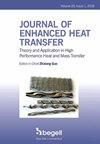Finned and unfinned thermal resistances of a metal foam under jet impingement conditions
IF 1.5
4区 工程技术
Q3 ENGINEERING, MECHANICAL
引用次数: 0
Abstract
Heat transfer in a flat plate with metal foam under impinging jet conditions is a complex combination of conduction (finned) and convection (unfinned) heat transfer. This study reports an analytical approach for the quantification of finned and unfinned heat transfer from a targeted plate with metal foam under impinging jet conditions. Along with the quantification of heat transfer modes, the interstitial heat transfer, the efficiency of metal foam as a fin, and thermal resistances are also quantified analytically. The analysis is carried out for rectangular slot jet and multiple air jet impingement conditions. The varying parameters are jet to plate spacing, metal foam thickness and Reynolds number. The results suggest that for the slot jet case, the finned and unfinned heat transfer is around 70 and 30 percent of the total heat transfer independent of the foam thickness. However, for multiple jet case, finned and unfinned heat transfer is around 50 percent each except for 12 mm thickness. The interstitial heat transfer coefficient and fin efficiency increase with a decrease in the thickness of the foam. For both slot and multiple jet impingement cases, the thermal resistance to unfinned heat transfer is more in comparison with the finned heat transfer. The presence of metal foam on the flat plate incenses the overall heat transfer by 2 times the smooth flat plate.喷射撞击条件下金属泡沫的有翅和无翅热阻
金属泡沫平板在冲击射流条件下的传热是传导(翅片)和对流(非翅片)传热的复杂组合。本研究报告介绍了一种分析方法,用于量化金属泡沫靶板在冲击射流条件下的翅片传热和非翅片传热。在对传热模式进行量化的同时,还对间隙传热、金属泡沫作为翅片的效率以及热阻进行了分析量化。分析针对的是矩形槽喷流和多空气喷流撞击条件。变化参数包括喷流与板的间距、金属泡沫厚度和雷诺数。结果表明,在槽形喷流情况下,翅片和非翅片传热分别约占总传热的 70% 和 30%,与泡沫厚度无关。然而,对于多重喷射情况,除 12 毫米厚度的泡沫外,翅片和非翅片的传热量各占 50%左右。间隙传热系数和鳍片效率随着泡沫厚度的减小而增加。在槽式和多喷流撞击两种情况下,非翅片传热的热阻都大于翅片传热。平板上金属泡沫的存在使整体传热量增加了 2 倍。
本文章由计算机程序翻译,如有差异,请以英文原文为准。
求助全文
约1分钟内获得全文
求助全文
来源期刊

Journal of Enhanced Heat Transfer
工程技术-工程:机械
CiteScore
3.60
自引率
8.70%
发文量
51
审稿时长
12 months
期刊介绍:
The Journal of Enhanced Heat Transfer will consider a wide range of scholarly papers related to the subject of "enhanced heat and mass transfer" in natural and forced convection of liquids and gases, boiling, condensation, radiative heat transfer.
Areas of interest include:
■Specially configured surface geometries, electric or magnetic fields, and fluid additives - all aimed at enhancing heat transfer rates. Papers may include theoretical modeling, experimental techniques, experimental data, and/or application of enhanced heat transfer technology.
■The general topic of "high performance" heat transfer concepts or systems is also encouraged.
 求助内容:
求助内容: 应助结果提醒方式:
应助结果提醒方式:


